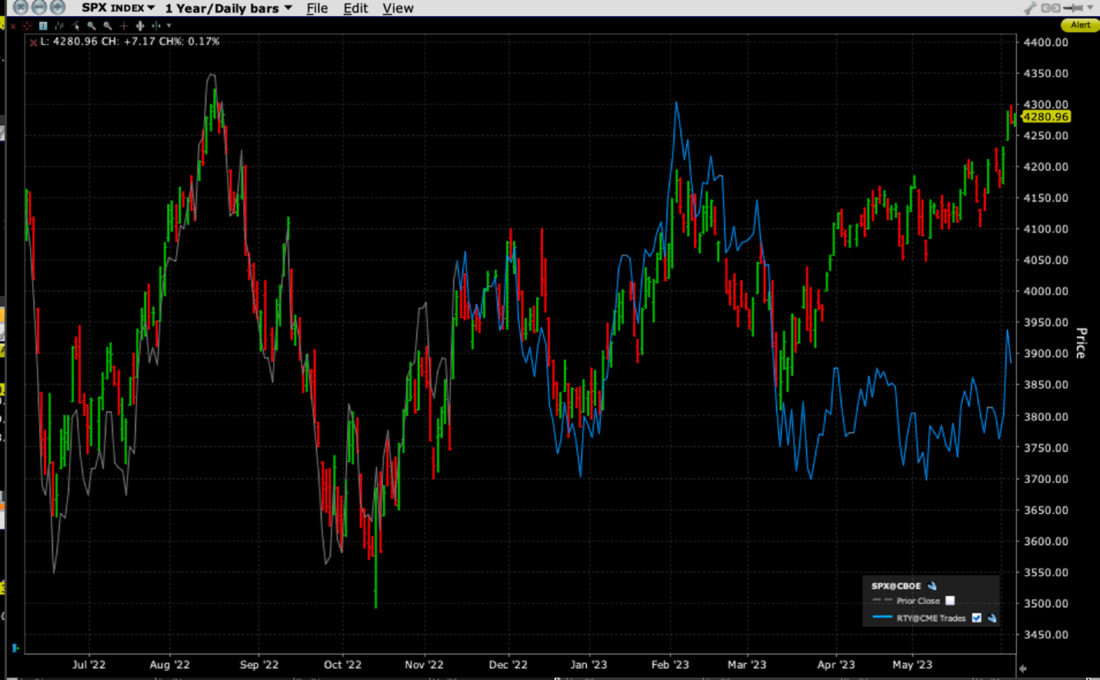Keeping An Eye On The Russell 2000
There has been no shortage of hand-wringing about the narrow leadership of the current rally – myself included. Although the majority of the divergences remain largely in place, an interesting development has been taking place over recent sessions. The best-performing US index has been the most broad-based and economically sensitive of all – the Russell 2000 (RTY).
To put it plainly, RTY has been ripping since Thursday. It’s clearly not a long-term trend, but its outperformance – particularly since Friday – has been stunning.
1-Week Chart, SPX (red/green 5-minute bars), RTY June Futures (purple line)
(Click on image to enlarge)

Source: Interactive Brokers
On Thursday, RTY roughly matched SPX’s 1% rise. But on Friday, RTY’s 3.56% leap far outpaced SPX’s 1.45%, and as I write this, RTY is up 2.7% with SPX up 0.23%. That said, RTY has been a major laggard over the past few months:
1-Year Chart, SPX (red/green daily bars), RTY (grey/blue line)
(Click on image to enlarge)

Source: Interactive Brokers
It is indeed welcome to see a rally broaden, but we have to wonder whether this is simply momentum traders cashing in and attempting to move into laggards rather than a meaningful vote about smaller stock outperformance. That the best-performing sector today is regional banking, the poster child for recent underperformance is a sign that the former may be the case. There is little fundamental reason for a 5% rally in that group, so it is undoubtedly a sector that has notable room to play catch up.
Regarding smaller stocks, they tend to outperform when the economy is robust. The logic for investing in RTY is essentially the polar opposite of the rationale for chasing large tech stocks. Even prior to the recent AI enthusiasm, the largest tech stocks were benefitting from the notion that their franchises were perceived as impenetrable in a slow-growth economy. Ask yourself now if the economic climate appears to be changing sufficiently to raise the tide for smaller stocks, many of which are unprofitable.
There is certainly nothing wrong with finding underperforming stocks and sectors. It’s what traders have been doing essentially forever, and pretty much the definition of “buy low, sell high” – at least when they rotate from the outperformers to the underperformers. The key decision becomes how far to chase the former underperformers when they pick up steam. If there is a solid investment thesis behind the sector in question, the timeframe for joining the fray is lengthened. If the logic is simply that there has been a temporary lag, then one needs to be quite careful about timing one’s exit.
Let’s see if there is real follow-through in the sectoral plays.If investment capital acknowledges that smaller stocks are investable asset in the current climate, then this would be a key sign of health for the equity markets. Yet we only see modest improvement so far in the advance/decline lines. They’ve stopped falling, but their rise is hardly commensurate with SPX and NDX, let alone RTY. For now, we’re encouraged by the recent change in leadership but think it’s premature to say that it is much more than the latest trend for aggressive traders.
More By This Author:
The FOMC Cha-Cha: Skip, Hike, Pause, Pivot
Today In Gloomy Charts
AI Is Worth The Hype If Everyone Believes It
Disclosure: The analysis in this material is provided for information only and is not and should not be construed as an offer to sell or the solicitation of an offer to buy any security. To the ...
more


